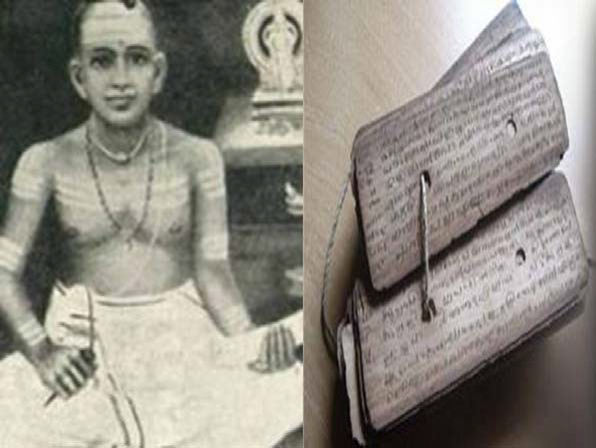Narayaneeyam: A Timeless Path to Inner Peace and Liberation

We are familiar with the 18 Puranas of Hinduism. Among these 18 puranas, Bhagavata Purana holds a higher status, portraying human life as a quest for self-realization through the conquest of inner demons and the pursuit of self-knowledge, salvation, and bliss. Bhagavata Purana is comprised of twelve books (skandhas or cantos) consisting of 335 chapters (adhyayas) and 18,000 verses.
In the fast-paced world of today, individuals are often so consumed by their work and responsibilities that they find little time for devotion and spiritual practices. In a society where evening prayers have been reduced to simply lighting a lamp and incense, the idea of reading 18,000 verses seems unattainable. This is where Narayaneeyam emerges as a divine gift to guide us towards spirituality and enlightenment.

Narayaneeyam is a Sanskrit text from the medieval era. It is a concise summary of the Bhāgavata Purana, composed of 1036 slokas by Melpathur Narayana Bhattathiri, a renowned Sanskrit poet from Kerala, who lived from 1560 to 1666 AD. Bhattathiri, a devoted follower of Lord Krishna, prayed to alleviate his Guru Achutha Pisharody’s rheumatism. His sincere plea to transfer his Guru’s illness onto himself was granted by Bhagavan. As a result, Bhattathiri’s Guru was cured, while Bhattathiri selflessly took on the affliction. Despite his suffering, Bhattathiri’s unwavering faith in Lord Krishna at Guruvayur remained steadfast.
Despite being plagued by acute rheumatism, he made a daily pilgrimage to Guruvayoor Temple. Each day, amidst intense agony, he fervently praised Bhagavan. Bhattathiri composed a dashakam every day, concluding each with a plea for the lord’s mercy and blessings. It is believed that after the 100th dashakam, the lord bestowed upon him a vision of his viswaroopa. Bhattathiri describes this moment as ‘Agre Pashyami’, as tears streamed down his face upon seeing Bhagavan’s ‘Keshadi Padam’, from head to toe. Remarkably, his ailments vanished completely from the very next day.
To achieve liberation from the eternal cycle of life and reach Moksha at the feet of Lord Krishna is the ultimate goal of all devotees. Similar to how Lord Krishna eradicated major suffering from Bhattathiri’s life, Narayaneeyam serves as a remedy for our spiritual afflictions, cleansing our soul and readying it for Moksha.
Narayaneeyam – Dhyana Slokam
Agajaanana Padmaarkam Gajaanana maharnisham
Aneka Dam Tam Bhaktaanam Eka Dantam Upasmahe
Shree mahaaganapataye namaha||
“I worship Lord Ganesha, who has the face of an elephant, who is the great Lord, who grants numerous blessings to his devotees, and who has only one tusk. Salutations to the great Lord Ganesha.”
Gurave sarvalokaanam
bhishaje bhavaroginam|
nidhaye sarvavidyanam
Shree dakshinamurtaye namaha||
Asmad Shree gurucharanaaravindaabhyaam namaha||
“Salutations to Lord Dakshinamurti, the Guru of all worlds, The healer of worldly afflictions, The repository of all knowledge.”
“I bow to the lotus feet of my revered Guru.”
jñānānanda mayaṃ devaṃ
nirmala sphaṭikākṛtiṃ|
ādhāraṃ sarva vidyānaṃ
Hayagreevam upaasmahe||
Shree hayagreeva moortaye namaha||
“I worship Lord Hayagriva, whose form is pure like a crystal, Who is the embodiment of knowledge and bliss, The foundation of all knowledge.”
Saraswathi Namasthubyam
Varade Kaamarupine|
Vidhyarambham Karishyami
Sidhir bhavathu mesada
Shree mahaa saraswatyai namaha||
“O Saraswati, I bow to you, Bestower of blessings and the form of desires, I shall commence my studies, May there always be success.”
Umaa komala hastaabja
Sambhaavita lalaatakam||
Hiranya kundalam vande
Kumaaram purushkarasrajam||
Vetrivel murukanukku hara haro hara||
“I worship Lord Murugan (Kumara), Whose mother is Uma with delicate lotus-like hands, Whose forehead is adorned with a mark, Whose ears are adorned with golden earrings, And who holds a spear as a symbol of valiance.”
“Hail to the Lord with the lance, Vanquisher of enemies!”
Komalam koojayam venum
Shyaamaloyam kumaarakaha|
Vedavedyam parambrahma
Bhaasataam purato mamaha|
“Softly plays the flute, the dark-skinned young Lord, Known as the knower of Vedas, the Supreme Brahman,
May He shine brightly before me.”
Saayankaale vanaante, kusumita samaye,
Saikate chandrikaayaam|
Trailokyaakarshananaangam, suravara ganikaa,
Mohanaapaangamoortim||
Sevyam shrngaara bhaavaihi
Navarasabhaaritaihi gopakanyaa sahasraihi|
Vande ham raasakeleeratamati subhagam
Vashya gopalaKrishnam||
“At dusk, in the forest grove, when flowers bloom, By the moonlit banks, With form captivating the three worlds, Surrounded by celestial maidens, enchanting in form, Adorned with love’s emotions, Filled with the essence of nine emotions, With thousands of gopis in service, I bow to Gopala Krishna, the enchanting one, Whose mind is immersed in the joyous Raasa dance.”
Aaneela shlakshna kesham, jvalita makarasat
Kundalam mandahaasa;
Syandaardram kaustubha shree, parigata,
Vanamaaloru haaraabhi-raamam,
Shree vatsaangam, subaahum, mrdulasad
Udaram, kaanchanach chaayachelam,
Chaaru snigdhorum ambhoruha,
Lalitapadam bhaavayeham bhavantam, ||
“Adorned with blue-hued, smooth locks of hair, Shining with a fiery crocodile-shaped earring, Smiling gently; Adorned with the Kaustubha jewel and a garland of wildflowers, Wearing the Vanamala, With the mark of Shreevatsa on the chest, with beautiful arms, Soft and tender belly, with a golden sheen, With charming and affectionate lotus-like feet, I meditate upon your graceful form.”
Shree Krishna Govinda hare Muraare
Shree naatha naaraayana Vaasudeva (3 times)
Mokshaabdhi saaramaya, bhaagavataakhya dadhno,
Naaraayaneeya navaneeta, mahogruheetvaa|
Maayaamayaugha paritapta, janaaya yogaatu,
Naaraayanaa avani, suraaya namostu tasmai||
“Salutations to Lord Narayana, Whose essence is the ocean of liberation, Holding the essence of Bhagavata, As the butter churned from the milk of Narayaneeya.
May the earth beneath Lord Narayana Be saluted by the gods, As it relieves the sufferings Of the multitude engulfed in the ocean of Maya.”
Gangaa geetaa cha, gaayatrayapicha
Tulasikaa, gopikaa chandanam tattu,
Saalagraamaabhipoojaa, parapurushatadhai
Kaadasi naama varnaahaa|
Etaney stapya yatnaanayi kalisamaye
Twratsaada pravrdhyaa
ksrpram muktipradhaanee tyabhida
rushayah, teshu maam, sajjaayethaahaa||
“The Ganges, the Bhagavad Gita, and the Gayatri mantra, Tulsi plant, gopika (cowherd girl), and sandalwood, Worship of Salagrama (sacred stone) and offering of the Purusha Sukta hymn, And the observance of Ekadashi fasts, These practices, when followed diligently in the current age of Kali, Quickly lead to liberation and grant immense benefits, As proclaimed by the wise sages; I surrender unto them.”
Sarvatra Govindanama sankeerthanam Govinda Govinda